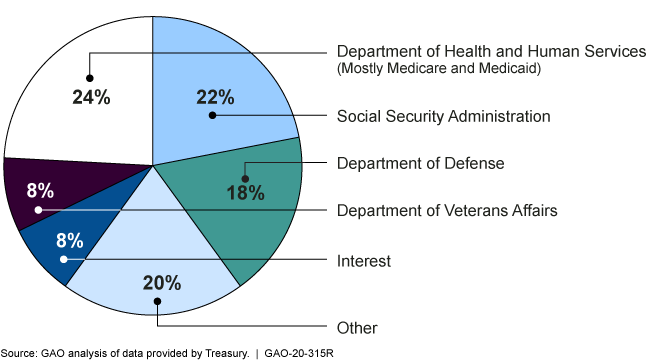Financial Audit: FY 2019 and FY 2018 Consolidated Financial Statements of the U.S. Government
Fast Facts
How much revenue does the U.S. government collect? What does it cost to run the government for a year? How and where is the money spent?
The Financial Report of the U.S. Government may have a lot of these answers, including information about taxes and major program costs.
We audit the financial statements in that report each year, but we haven't yet been able to determine if the statements fairly present the government’s finances. This year, it was due in part to:
Serious financial management problems at DOD
Inadequate accounting for balances between federal agencies
Weaknesses in the process for preparing the statements
2019 Net Costs of the U.S. Government ($5.1 trillion)

Pie chart
Highlights
What GAO Found
To operate as effectively and efficiently as possible, Congress, the administration, and federal managers must have ready access to reliable and complete financial and performance information—both for individual federal entities and for the federal government as a whole. GAO's report on the U.S. government's consolidated financial statements for fiscal years 2019 and 2018 discusses progress that has been made but also underscores that much work remains to improve federal financial management and that the federal government continues to face an unsustainable long-term fiscal path.
GAO found the following:
- Certain material weaknesses in internal control over financial reporting and other limitations resulted in conditions that prevented GAO from expressing an opinion on the accrual-based consolidated financial statements as of and for the fiscal years ended September 30, 2019, and 2018. About 29 percent of the federal government's reported total assets as of September 30, 2019, and approximately 19 percent of the federal government's reported net cost for fiscal year 2019 relate to significant federal entities that received a disclaimer of opinion or qualified opinion on their fiscal year 2019 financial statements or whose fiscal year 2019 financial information was unaudited.
- Significant uncertainties, primarily related to the achievement of projected reductions in Medicare cost growth, prevented GAO from expressing an opinion on the sustainability financial statements, which consist of the 2019 and 2018 Statements of Long-Term Fiscal Projections; the 2019, 2018, 2017, 2016, and 2015 Statements of Social Insurance; and the 2019 and 2018 Statements of Changes in Social Insurance Amounts. About $42.2 trillion, or 71 percent, of the reported total present value of future expenditures in excess of future revenue presented in the 2019 Statement of Social Insurance relates to Medicare programs reported in the Department of Health and Human Services' 2019 Statement of Social Insurance, which received a disclaimer of opinion. A material weakness in internal control also prevented GAO from expressing an opinion on the 2019 and 2018 Statements of Long-Term Fiscal Projections.
- Material weaknesses resulted in ineffective internal control over financial reporting for fiscal year 2019.
- Material weaknesses and other scope limitations, discussed above, limited tests of compliance with selected provisions of applicable laws, regulations, contracts, and grant agreements for fiscal year 2019.
Three major impediments have continued to prevent GAO from rendering an opinion on the federal government's accrual-based consolidated financial statements over this period: (1) serious financial management problems at the Department of Defense (DOD), (2) the federal government's inability to adequately account for intragovernmental activity and balances between federal entities, and (3) weaknesses in the federal government's process for preparing the consolidated financial statements. Efforts are under way to resolve these issues, but strong and sustained commitment by DOD and other federal entities, as well as continued leadership by the Department of the Treasury (Treasury) and the Office of Management and Budget (OMB), are necessary to implement needed improvements.
Material weaknesses underlying these three major impediments have continued to (1) hamper the federal government's ability to reliably report a significant portion of its assets, liabilities, costs, and other related information; (2) affect the federal government's ability to reliably measure the full cost, as well as the financial and nonfinancial performance, of certain programs and activities; (3) impair the federal government's ability to adequately safeguard significant assets and properly record various transactions; and (4) hinder the federal government from having reliable, useful, and timely financial information to operate effectively and efficiently.
In addition to the three major impediments, GAO identified three other material weaknesses. These are the federal government’s inability to (1) determine the full extent to which improper payments occur and reasonably assure that appropriate actions are taken to reduce them, (2) identify and resolve information security control deficiencies and manage information security risks on an ongoing basis, and (3) effectively implement internal controls over estimating the cost of credit programs and determining the value of loans receivable and loan guarantee liabilities.
The comprehensive long-term fiscal projections presented in the Statement of Long-Term Fiscal Projections and related information show that absent policy changes, the federal government continues to face an unsustainable long-term fiscal path in which debt is projected to grow faster than gross domestic product. GAO plans to issue its annual report on the fiscal health of the federal government.
Why GAO Did This Study
The Secretary of the Treasury, in coordination with the Director of OMB, is required to annually submit audited financial statements for the U.S. government to the President and Congress. GAO is required to audit these statements. The Government Management Reform Act of 1994 has required such reporting, covering the executive branch of government, beginning with financial statements prepared for fiscal year 1997. The consolidated financial statements include the legislative and judicial branches.
For more information, contact Dawn Simpson at (202) 512-3406 or simpsondb@gao.gov or Robert F. Dacey at (202) 512-3406 or daceyr@gao.gov.
